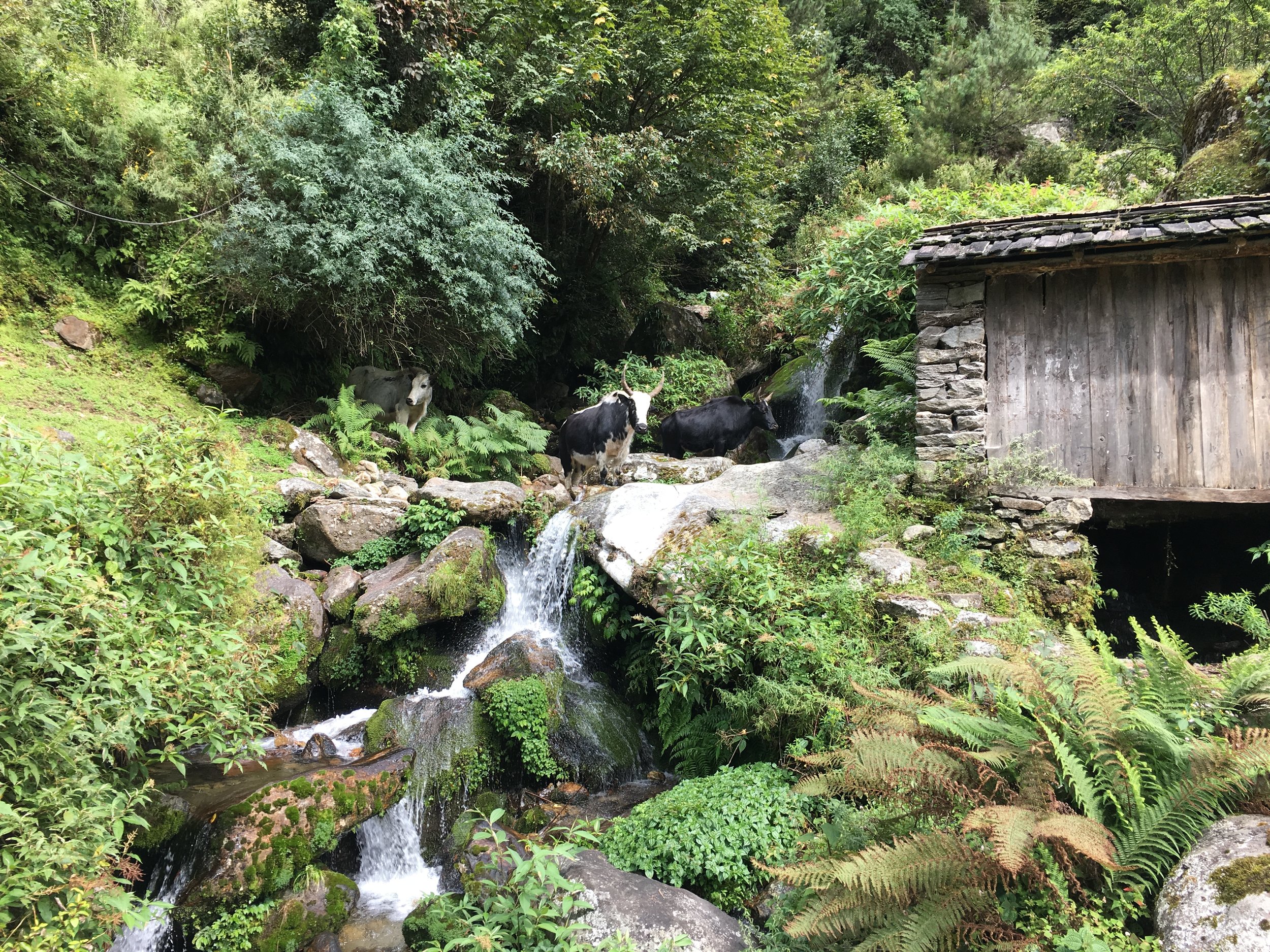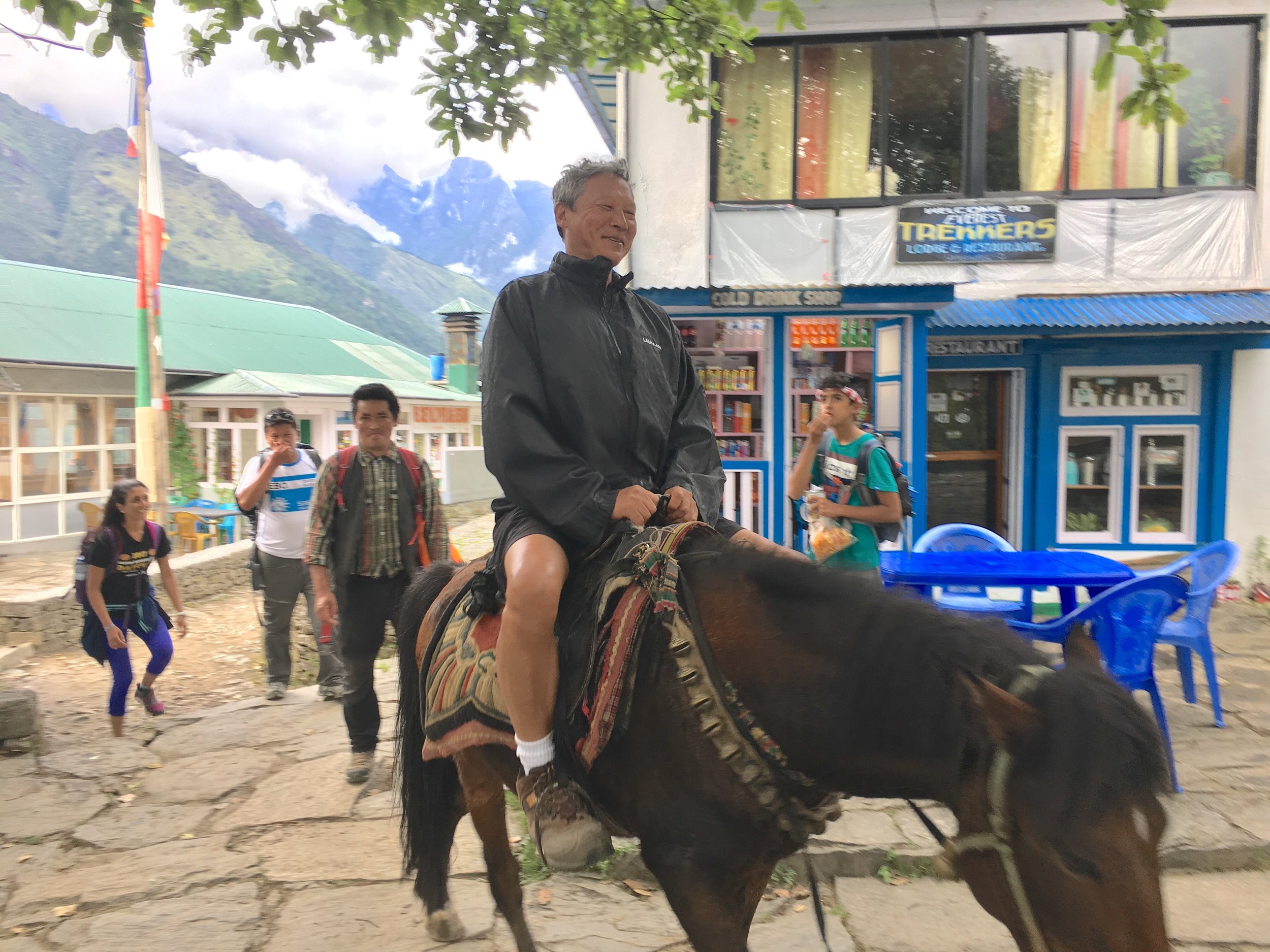"Jum Jum" said the dragon, and off we went. Just put one foot in front of the other, and repeat. Eventually we will get from Lukla, Nepal, to Everest Base Camp. It’ll only take 8 days.
"Jum Jum" is Nepalese for "Let's go". Our assistant guide, 19 year old Draigon, softly uttered these words at the start of every day, as well as after every tea and lunch stop, and indeed after every 3 minute pause to gasp for air and sip water. Despite his tender age he set the pace really well, taking into account the three 60 year olds in our party of six.
We were all strangers in the Himalayas together, but united by a single goal: Everest. I have often wondered how strangers can get along so well. Our backgrounds, country of origin, culture even, were all so different. Yet we enjoyed the most heartwarming, intimate, and mutually supportive two weeks together. Conversations flowed endlessly and covered every subject - family, friends, love, work, travel, politics and religion. Dawa, our lead guide and sherpa, needed to know at all times how we were feeling, and how our bodies were reacting to the altitude and diet. Consequently, all intimate details were shared!
15 year old Khalil hopped and skipped uphill with a passion and enthusiasm that defied his age, never complaining once. “Would it help if I complained?”, he asked. He was a credit to his father who was usually a step or two behind him. Abdul paused to give a wrapped sweet to every child he passed en route. Generous with all, at the end of the trek he gave us a personalised memento of our time together. Hand carved in Nepalese slate, each bears our name and EBC 17, the local abbreviation for Everest Base Camp. Praful and I tended to take up the middle of the group. We huffed and puffed and sweated or way along together. Deepa, his daughter and marathon runner, was equally delightful company, and admired for her fitness. My room mate, Chang, was often at the rear, stopping to take the most photographs. He was the joker in the group, cracking comments, one liners, and searching questions to keep us all alert. Dawa took up the rear. “If you see Yaks coming towards you, stick to the inside of the path. They sometimes wobble and might knock you over the edge”. We didn’t challenge the advice.
Every step has to be taken with care. Uneven steps and occasional flat gravel are welcome passages. More often the path was vertiginous, both up and down. Quads burned, thighs throbbed, knees swelled, toes were crushed, lungs gasped, sweat poured and increasing altitude affected our cognitive ability. Occasional dizziness and headaches left us all questioning our determination from time to time. An established technique is to climb higher and sleep lower; that may have helped.
The small houses lining the route are simply constructed from wood or stone, with tin roofs. Many have tiny fields beside them, growing root vegetables, but with the odd flower bed. Quite a few of the hamlets had a community room, which to our very great surprise often contained full size snooker tables, always occupied.
The tea houses offering cooked food were really quite good. There are many dishes built around pasta, rice, potatoes or vegetables. A chicken dish or two makes an appearance now and then, but otherwise meat is not available. Accommodation was simple with a clean bed but very limited bathroom facilities. Toilets were flushed with a jug of water, basins with a rudimentary flow of water were always communal, and hot showers were a lamentable after-thought. We never complained. Life is very simple for the locals. There is no mains electricity. Solar panels charge large batteries to run dim light bulbs. Bottled gas is carried by porters or Yaks for cooking. Wood or peat stoves keep the living space warm at night.
When you pause to gaze up at the hills on each side of the valleys, you are struck by their size and beauty as the tree line fades in to the clouds. From time to time the parting clouds reveal a sight of unimaginable scale. A white wall, with rocky outcrops, rising like shards to pierce the sky above. The Himalayas are huge!
There are a couple of buddhist monasteries en route with a large one in Tengboche at 3,870 metres. Sharing a celebration with the monks which included rhythmic chanting, simple instruments and incense was a humbling experience.
Once the trees and tufts of grass are left behind, the fearsome rocks lend themselves less suitable for allowing a path to be created. The tail end of the Khumbu glacier then appears underfoot. It is covered in loose moraine, but we follow the side of it as best we can. The icy broken leading edge of the glacier pushes us away from it slightly as we lose sight of Everest. Base Camp is empty in September but the grey rocky terrain and the low grey cloud does not dampen the elation of the achievement.
The best view of the summit of Mount Everest, my personal goal, was from Kala Pathar. Seeing the top of the world revealed by the rising sun, whilst alone on a side track, brought a flood of emotions. For as long as I can remember I have been fascinated by the mountain. A school visit by the successful 1953 expedition leader, Colonel John Hunt, ignited the dream, and becoming a Fellow of the Royal Geographic Society a few years ago, fuelled it. I cried.
The arduous accent was complemented by the speed of the descent, although it still had a number of uphill passages to challenge us. On the last afternoon, Chang was suffering from cramp in his left leg. He was embarrassed by the thought of hiring a horse to complete the trek but eventually conceded that it was the best option. ‘Emperor Chang’ rode in to town right up to the front door of our final tea house.
L-R: Draigon, Chang, Deepa, Praful, Dawa, Abdul, Khalil, Mark.
Mount Everest
Alone with my mountain.
Tengboche Monastery.
Emperor Chang.










